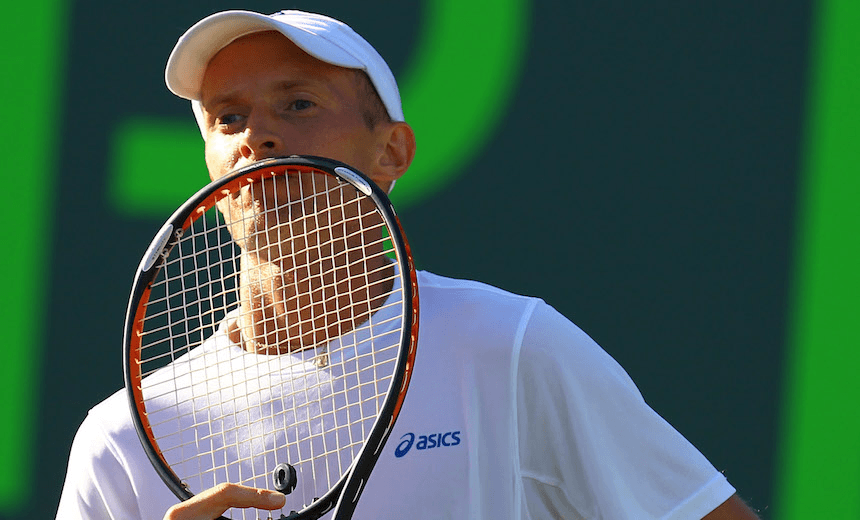In the wake of the Buzzfeed/BBC investigation into match-fixing in tennis, we spoke to two members of the international sports betting industry to understand how the matches get rigged. The identities of both the journalist and the employees have been withheld in return for their speaking candidly on this issue.
Chris Kermode, head of the Association of Tennis Professionals (ATP) thinks tennis is fine. He claims match-fixing in tennis remains at an “incredibly small level”, despite the BBC and Buzzfeed investigation which has uncovered evidence of fixing by at least 16 top-50 players over the last decade.
“Incredibly small” in this case is open to interpretation. To understand the problems in tennis, one must understand the size of the market. And to do that, we head back to the grand-daddy of all the past decade’s suspicious matches, the Nikolai Davydenko v Martin Vassallo Aguello match in 2007.
What made this match so incredible was not the quality of tennis. Instead, it was the sheer weight of betting. Arguello, ranked 87 in the world was a $6 outsider when betting opened, yet by the time the match began he had received such a volume of money backing him that he became a $1.51 favourite. He remained favourite during the live betting, despite getting hammered 6-2 in the first set.
More remarkably, after three games in the second set, Arguello went further behind on the scoreboard, and further ahead on the betting odds. At 1-2 down in that second set he was now paying $1.06 to win the match – odds you would struggle to find on a world number 1, let alone on the number 87 who is already a set down and trailing in the second.
Arguello won the set. Davydenko retired injured in the third.
The Tennis Integrity Unit (TIU) and the ATP investigated the match in the longest-ever inquiry into fixing in the sport. After 18 months, both players were cleared of any wrongdoing, and it was discovered that nine Russian punters had bet US$1.5m on Davydenko losing. A further two unknown people cleared US$6m from the result on a betting exchange.
So what is the size of the market? Those figures are based on one match and already there are tens of millions of dollars in betting revenue. The ATP this year will host 62 tournaments in 31 countries which, represents 964 separate matches by the end of February alone. If each of those represents a worldwide betting market of, say, US$1m (and that’s a conservative average given the Australian Open is included in this time period) that is a US$1billion betting market in just the first two months of the year.
It gets more complex. For every one of those 964 separate matches, there are any number of distinct betting options. For the Australian Open, for instance, the largest betting exchange in the world, Bet Fair, listed 25 separate betting options on one men’s singles game. These options ranged from outright winner to individual set winners, to exact set scores, to handicaps, to game lines to simple Yes/No options for tie-breaks and six-love sets.
Consider the market now: 964 matches on the ATP tour just in January and February this year, with up to 25 betting options per match on just one betting exchange (and there are now also thousands of online bookmakers, including William Hill, an official sponsor of the Australian Open). That’s close to 25,000 ways to place a bet on a game of tennis on one largely anonymous site that allows its punters (numbered in the millions) to buy and to sell options.
Which brings us to the ease of the betting exchange and the problems with policing betting activity therein. In short, a betting exchange, unlike a bookmaker, does not set odds for its customers, nor hold any liability. Instead each operates as a betting free-market, where punters buy and sell odds in a live environment, and the site then clips the ticket on transactions, much like an online auction house.
In short, each punter can play both buyer and seller, the idea being to buy when the odds are high (maximising your potential profit) and sell when the odds are shorter (minimising your liability). It all sounds very simple and, because of that, very appealing. Punters are ostensibly traders and the best of them understand the mathematics behind guaranteeing a profit on transactions. The maths is not overly complicated, and forms the basic theory behind any type of bookmaking.
That’s all well and good – except when the seller knows something the buyer doesn’t. Which in this case could be that the player they are selling is going to lose the match. Moreover, in terms of suspicious activity, because the exchanges operate outside the traditional bookmaker intercepts (a shared network that warns of strange betting patterns or arbitrage punters), trades are not notified, nor is betting ever suspended. There are many betting insiders who believe the rise of the betting exchange and the rise of match-fixing are indisputably linked.
So how does it work? Let’s say you have Player X in your pocket and Player X is a massive outsider. Let’s say he or she started at around $3.50 to win the match and is crushed 6-0 in the first set. Their price suddenly shoots out to $7 to win the match. You buy $1000 worth of Player X to win at $7 for a potential profit of $6,000.
Then Player X wins the second set, and suddenly the price is slashed to $4 to win the match. You sell $1400 worth of player X at $4. If the favourite comes back to win the match (and fixers may only worry about the first two sets in order to create the guaranteed profit scenario) you have made $400 profit on the sale. If player X goes on to win the match you have made $400 on the bet. In other words, you can’t lose.
Now pretend those transactions are for $100,000 in a match instead of $1,000. Now do that repeatedly, all season long.
And that’s just one scenario. The better the player involved, the easier it is to manipulate the match. A highly ranked player in a match against a lowly outsider would be very capable of dropping a couple of service games (in men’s tennis the chances of holding serve are better than those in the women’s game) in order to effect the desired set score, for instance.
Still think the potential for match fixing is at at “incredibly small level”?
Insiders spoken to for this story say there was no evidence of potential fixing in the recently completed ASB Classic event in Auckland, though the threat to the profile of the Australian Open posed by the BBC-Buzzfeed story (which is due to air in the UK this week) will have organisers ducking for cover.
That the report claims to have names of suspected match fixers and to have evidence of a lack of investigative bite from the TIU is damning in and of itself. Claims from professional tennis that warnings they have received from betting agencies don’t amount to grounds for investigation are strange too. Especially when these are the very organisations that can spot unorthodox betting patterns – which are ultimately at the heart of every fix.
Harder still for the sport is that many of the alleged fixing incidents happen in tournaments that don’t have the prestige of the grand slams or the Masters events. These are the ones that seem ripe for the picking given the lack of attention in terms of television audience, and anti-corruption officials.
One Australian betting insider spoken to for this piece told The Spinoff that professional punters have known for a long time that tennis has a major issue with match fixing, and have learned to spot the potential fixes that are run through the exchange system.
The problem, he says, is that there are milions of people who don’t know how to spot them.
At the moment, there also seems to be a lot of people who just don’t want to.





